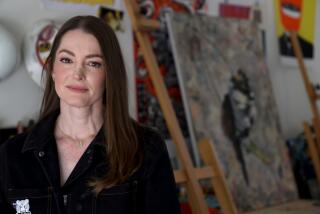Dilbert Doesn’t Live Here
- Share via
On Steve Hillenburg’s office door at the Nickelodeon Animation Studio, a sign says, “Have Fun or You’re Fired.” A colleague put it up after Hillenburg, the 38-year-old creator of a cartoon series about the underwater adventures of a sea sponge, supposedly spoke those words at a staff meeting. While Hillenburg doesn’t recall issuing such an edict, it looks like the people who work for him took it to heart. How else would you explain the unbridled mirth with which “SpongeBob SquarePants” staffers have decorated their office cubicles--work spaces where cocktail umbrellas, crepe-paper pineapples and souvenir ukuleles are as common as the potted plants and family photos that pass for personal embellishments in most corporate environments? In fact, a similarly irreverent design ethic prevails throughout the 1 1/2-year-old Burbank studio, home to 270 employees, average age 34. Within their 8-foot-square “cubes,” animators and production assistants pay homage to their interests and obsessions with the care of museum curators, lining up action figures, windup toys, stuffed animals and even Dixie cups as if they were Lalique collectibles. Says Shoshana Stolove, 29, an inker whose Renaissance-motif cubicle sports silk flower garlands, goddess posters and strings of gold beads draped over the desk lamp: “I needed someplace of my own that made it feel like home.” Nickelodeon executives never told employees they had free rein to adorn their work areas. They didn’t have to. Custom-designed in the kitschy, vintage L.A. style known as “Googie,” the studio building, which occupies a former record manufacturing plant, speaks for itself. Along with couches and armchairs that look as if they were pumped up on steroids, the lobby is dominated by a chartreuse staircase that imitates Nick’s signature Slime. While waiting for the muse, artists can blow off steam at a nearby company-owned park or shoot hoops on the indoor basketball court that does double duty as an auditorium.
“They kind of have to let us do what we want because they want to encourage creative expression,” says Derek Iversen, 28, a production assistant whose desktop computer wears a fanciful fringe fashioned from pieces of Scotch tape, Post-it notes, file folder stickers and mailing labels. (The design statement had purely utilitarian roots, since one of Iversen’s jobs is taping dialogue on storyboards.) “If I had to work in some dull, lifeless place, it would make it that much harder.”
Of course, given the famous disrepute that cubicles have fallen into of late (Gen X author Douglas Coupland defined them as “veal fattening pens”), a customized computer might strike some artistically inclined purists as the ultimate cop-out. Still, laissez-faire attitudes like the one at Nickelodeon remain more the exception than the rule, although corporations that are hoping to attract and retain young “Dilbert”-jaded employees may have no choice in the future but to promote freer workplace attitudes, says Marilyn Zelinsky, author of “New Workplaces for New Workstyles.”
“I’ve never heard anyone say personalization of office space makes the employee less productive. I think it’s just the opposite,” Zelinsky says. “It’s alienating to be told you are going to sit there for eight hours and it’s going to be a jail cell.” In fact, those cells in maximum-security prisons just might be more decorative than the pods of corporate America.
More to Read
The biggest entertainment stories
Get our big stories about Hollywood, film, television, music, arts, culture and more right in your inbox as soon as they publish.
You may occasionally receive promotional content from the Los Angeles Times.










